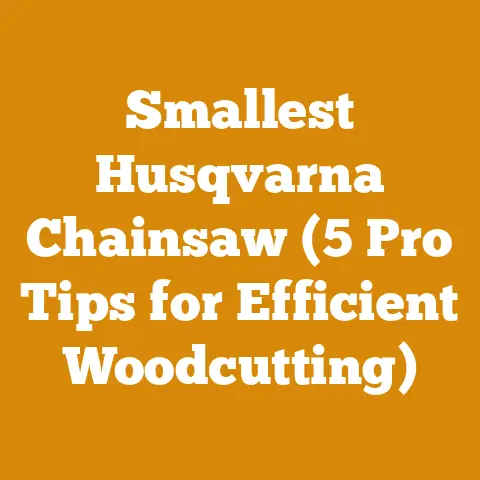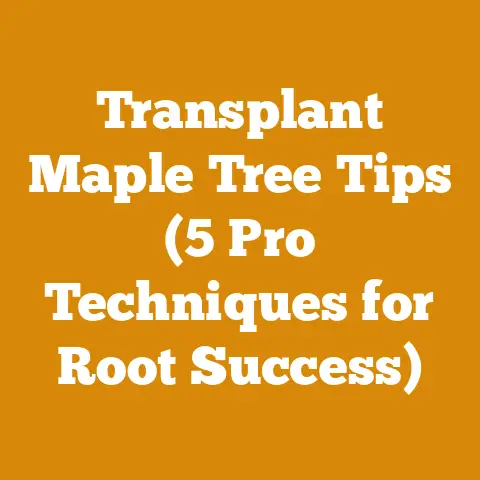How Do I Get Rid of Bagworms (5 Proven Arborvitae Treatments)
Living sustainably often means protecting the beauty and health of our landscapes. And nothing adds elegance and privacy to a yard quite like arborvitae trees. But these evergreens can sometimes face challenges, like bagworms. As someone who has spent countless hours in the woods, felling trees, processing wood, and dealing with various arboreal issues, I’ve learned a thing or two about tackling pests effectively. In this guide, I’ll share my knowledge on how to get rid of bagworms on arborvitae trees, drawing from both my personal experiences and proven methods. Let’s dive in!
How Do I Get Rid of Bagworms? (5 Proven Arborvitae Treatments)
Bagworms are destructive pests that can quickly defoliate and even kill arborvitae trees if left unchecked. These caterpillars create distinctive cone-shaped bags made of silk and foliage, making them relatively easy to spot. Early detection and prompt treatment are crucial for protecting your trees.
Understanding Bagworms
Before we jump into treatments, let’s understand what we’re dealing with. Bagworms are the larval stage of moths belonging to the family Psychidae. The female bagworm never leaves her bag, mating and laying eggs inside before dying. These eggs overwinter inside the bag and hatch in late spring or early summer.
- Life Cycle: Bagworms emerge from their eggs, begin feeding on foliage, and construct their protective bags. As they grow, they enlarge their bags, incorporating more plant material. Once fully grown, they pupate within their bags and emerge as adult moths.
- Damage: Bagworms feed voraciously on the foliage of arborvitae trees, causing defoliation, stunted growth, and eventual death if infestations are severe.
- Identification: Look for small, brown, cone-shaped bags hanging from the branches of your arborvitae trees. These bags are typically 1-2 inches long and camouflaged with bits of foliage.
Treatment Options: My Battle Plan Against Bagworms
Over the years, I’ve experimented with various methods to control bagworms on arborvitae trees. Here are five proven treatments that I’ve found to be most effective:
- Handpicking: The first line of defense.
- Bacillus Thuringiensis (Bt) Sprays: A biological control method.
- Insecticidal Soap: A gentle yet effective solution.
- Chemical Insecticides: For severe infestations.
- Preventative Measures: The best long-term strategy.
Let’s explore each of these treatments in detail.
1. Handpicking: The First Line of Defense
Handpicking is a simple yet effective method for controlling bagworms, especially when infestations are small and localized. This is often my go-to approach for newly discovered infestations.
How to Handpick Bagworms
- Timing: The best time to handpick bagworms is in late fall, winter, or early spring before the eggs hatch. You can also handpick them during the growing season, but it’s more effective to target them before they cause significant damage.
- Tools: All you need is a pair of gloves, a bucket, and a ladder if necessary to reach higher branches.
- Procedure:
- Inspect your arborvitae trees carefully, looking for the characteristic cone-shaped bags.
- Gently pluck the bags from the branches, being careful not to damage the foliage.
- Drop the bags into a bucket filled with soapy water to kill the bagworms inside.
- Dispose of the bags properly by burning them or burying them deep in the ground.
My Personal Experience: A Story of Early Detection
I remember one year when I noticed a few small bags on my neighbor’s arborvitae hedge. I pointed it out, and he quickly handpicked them, preventing a full-blown infestation. It’s a testament to how effective early detection and handpicking can be.
Benefits of Handpicking
- Environmentally Friendly: Handpicking is a non-toxic method that doesn’t harm beneficial insects or the environment.
- Cost-Effective: It requires minimal equipment and is a relatively inexpensive way to control bagworms.
- Targeted: Handpicking allows you to target bagworms directly without affecting other plants or organisms.
Limitations of Handpicking
- Time-Consuming: Handpicking can be time-consuming, especially for large trees or heavy infestations.
- Limited Reach: It may be difficult to reach bagworms on tall trees or dense foliage.
- Not Suitable for Severe Infestations: Handpicking is not practical for controlling severe bagworm infestations.
Key Takeaways
- Handpicking is most effective for small, localized infestations.
- Regularly inspect your arborvitae trees for bagworms.
- Dispose of collected bags properly to prevent re-infestation.
Next up, let’s explore a biological control method: Bacillus Thuringiensis (Bt) sprays.
2. Bacillus Thuringiensis (Bt) Sprays: A Biological Control Method
Bacillus Thuringiensis (Bt) is a naturally occurring bacterium that produces toxins that are harmful to certain insects, including bagworms. Bt sprays are a popular choice for controlling bagworms because they are effective, environmentally friendly, and safe for humans and pets.
How Bt Sprays Work
Bt sprays contain spores of the Bacillus Thuringiensis bacterium. When bagworms ingest these spores, the toxins produced by the bacteria disrupt their digestive system, causing them to stop feeding and eventually die.
Types of Bt Sprays
There are several different strains of Bt, each effective against specific types of insects. For bagworms, the Bacillus Thuringiensis kurstaki (Btk) strain is most commonly used.
Applying Bt Sprays
- Timing: The best time to apply Bt sprays is in late spring or early summer when the bagworms are young and actively feeding.
- Preparation: Follow the instructions on the product label carefully. Dilute the Bt concentrate with water according to the recommended ratio.
- Application: Use a pump sprayer or backpack sprayer to apply the Bt solution to your arborvitae trees. Be sure to cover all foliage thoroughly, paying particular attention to areas where bagworms are present.
- Frequency: Repeat the application every 7-10 days, or as directed by the product label, until the bagworms are controlled.
My Personal Experience: A Success Story with Bt
I once helped a friend who had a moderate bagworm infestation on his arborvitae trees. We applied Bt sprays according to the instructions on the label, and within a few weeks, the bagworm population had significantly declined. It was a satisfying experience to see the trees recover and thrive.
Benefits of Bt Sprays
- Environmentally Friendly: Bt is a natural product that is safe for humans, pets, and beneficial insects.
- Effective: Bt sprays are highly effective against bagworms when applied correctly.
- Easy to Use: Bt sprays are easy to apply with a standard pump sprayer.
Limitations of Bt Sprays
- Timing is Critical: Bt sprays are only effective against young bagworms.
- Requires Repeated Applications: Bt sprays need to be applied multiple times to achieve optimal control.
- May Not Be Effective Against Large Bagworms: Bt sprays may not be effective against large bagworms that have already developed their protective bags.
Key Takeaways
- Bt sprays are a safe and effective way to control bagworms.
- Apply Bt sprays in late spring or early summer when bagworms are young.
- Follow the instructions on the product label carefully.
Next, let’s explore another gentle yet effective solution: insecticidal soap.
3. Insecticidal Soap: A Gentle Yet Effective Solution
Insecticidal soap is a popular choice for controlling a wide range of pests, including bagworms. It’s a gentle yet effective solution that is safe for humans, pets, and the environment when used correctly.
How Insecticidal Soap Works
Insecticidal soap works by disrupting the outer layer of the bagworms’ bodies, causing them to dehydrate and die. It’s most effective against soft-bodied insects, such as young bagworms.
Types of Insecticidal Soap
Insecticidal soap is typically made from potassium salts of fatty acids. It’s available in concentrate form, which you need to dilute with water before use, or as a ready-to-use spray.
Applying Insecticidal Soap
- Timing: The best time to apply insecticidal soap is in late spring or early summer when the bagworms are young and actively feeding.
- Preparation: Follow the instructions on the product label carefully. Dilute the insecticidal soap concentrate with water according to the recommended ratio.
- Application: Use a pump sprayer or backpack sprayer to apply the insecticidal soap solution to your arborvitae trees. Be sure to cover all foliage thoroughly, paying particular attention to areas where bagworms are present.
- Frequency: Repeat the application every 7-10 days, or as directed by the product label, until the bagworms are controlled.
My Personal Experience: A Gentle Approach
I once used insecticidal soap to control a minor bagworm infestation on my ornamental shrubs. I appreciated that it was a gentle and non-toxic solution that didn’t harm the beneficial insects in my garden.
Benefits of Insecticidal Soap
- Environmentally Friendly: Insecticidal soap is a non-toxic solution that is safe for humans, pets, and beneficial insects.
- Effective: Insecticidal soap is effective against young bagworms when applied correctly.
- Easy to Use: Insecticidal soap is easy to apply with a standard pump sprayer.
Limitations of Insecticidal Soap
- Requires Direct Contact: Insecticidal soap only works when it comes into direct contact with the bagworms.
- Short Residual Activity: Insecticidal soap has a short residual activity, meaning it breaks down quickly and doesn’t provide long-lasting protection.
- May Not Be Effective Against Large Bagworms: Insecticidal soap may not be effective against large bagworms that have already developed their protective bags.
Key Takeaways
- Insecticidal soap is a gentle and effective way to control young bagworms.
- Apply insecticidal soap in late spring or early summer when bagworms are young.
- Follow the instructions on the product label carefully.
Now, let’s move on to chemical insecticides for severe infestations.
4. Chemical Insecticides: For Severe Infestations
When bagworm infestations are severe and other methods have failed, chemical insecticides may be necessary to protect your arborvitae trees. However, it’s important to use chemical insecticides judiciously and follow all safety precautions to minimize the risk to humans, pets, and the environment.
Types of Chemical Insecticides
Several chemical insecticides are effective against bagworms, including:
- Pyrethroids: These synthetic insecticides mimic the effects of natural pyrethrins, which are derived from chrysanthemum flowers. Examples include permethrin, cyfluthrin, and bifenthrin.
- Organophosphates: These insecticides are highly effective against a wide range of pests, but they are also more toxic than pyrethroids. Examples include malathion and acephate.
- Carbamates: These insecticides are similar to organophosphates in their mode of action, but they are generally less toxic. An example is carbaryl.
Applying Chemical Insecticides
- Timing: The best time to apply chemical insecticides is in late spring or early summer when the bagworms are young and actively feeding.
- Preparation: Follow the instructions on the product label carefully. Dilute the insecticide concentrate with water according to the recommended ratio.
- Application: Use a pump sprayer or backpack sprayer to apply the insecticide solution to your arborvitae trees. Be sure to cover all foliage thoroughly, paying particular attention to areas where bagworms are present.
- Safety Precautions: Wear protective clothing, including gloves, a long-sleeved shirt, long pants, and a respirator, when applying chemical insecticides. Avoid spraying on windy days to prevent drift. Keep children and pets away from treated areas until the insecticide has dried.
My Personal Experience: A Last Resort
I once had to resort to using a chemical insecticide to control a severe bagworm infestation on a client’s property. I carefully followed all safety precautions and applied the insecticide according to the instructions on the label. While it was effective in controlling the bagworms, I always prefer to use less toxic methods whenever possible.
Benefits of Chemical Insecticides
- Highly Effective: Chemical insecticides are highly effective against bagworms, even in severe infestations.
- Long Residual Activity: Some chemical insecticides have a long residual activity, providing long-lasting protection against bagworms.
Limitations of Chemical Insecticides
- Toxic to Humans and Pets: Chemical insecticides can be toxic to humans and pets if not used properly.
- Harmful to Beneficial Insects: Chemical insecticides can harm beneficial insects, such as pollinators and predators.
- Environmental Concerns: Chemical insecticides can contaminate soil and water, posing risks to the environment.
Key Takeaways
- Use chemical insecticides as a last resort for severe bagworm infestations.
- Follow all safety precautions when applying chemical insecticides.
- Consider the potential risks to humans, pets, and the environment.
Finally, let’s discuss preventative measures to keep bagworms at bay.
5. Preventative Measures: The Best Long-Term Strategy
The best way to deal with bagworms is to prevent them from infesting your arborvitae trees in the first place. By taking proactive measures, you can create an environment that is less attractive to bagworms and more resistant to their attacks.
Cultural Practices
- Maintain Healthy Trees: Healthy trees are more resistant to pests and diseases. Provide your arborvitae trees with proper watering, fertilization, and pruning to keep them healthy and vigorous.
- Prune Infested Branches: Regularly inspect your arborvitae trees for signs of bagworms. Prune and dispose of any infested branches to prevent the infestation from spreading.
- Remove Host Plants: Bagworms can also infest other types of trees and shrubs, such as junipers, pines, and spruces. Remove any host plants near your arborvitae trees to reduce the risk of infestation.
Biological Control
- Encourage Natural Predators: Encourage natural predators of bagworms, such as birds, parasitic wasps, and lacewings, to inhabit your garden. Provide them with food, water, and shelter to attract them to your property.
- Release Beneficial Insects: You can also purchase and release beneficial insects, such as parasitic wasps, to control bagworms. These wasps lay their eggs inside the bagworms’ bodies, eventually killing them.
Monitoring
- Regular Inspections: Regularly inspect your arborvitae trees for signs of bagworms, especially in late spring and early summer. Early detection is crucial for preventing severe infestations.
- Sticky Traps: Use sticky traps to monitor bagworm populations. Hang the traps near your arborvitae trees to capture adult moths.
My Personal Experience: A Proactive Approach
I’ve always believed that prevention is the best medicine, and that holds true for bagworms as well. By maintaining healthy trees, encouraging natural predators, and regularly monitoring my plants, I’ve been able to keep bagworm infestations to a minimum.
Benefits of Preventative Measures
- Reduces the Need for Pesticides: Preventative measures can reduce or eliminate the need for chemical insecticides.
- Protects the Environment: Preventative measures are environmentally friendly and don’t pose risks to humans, pets, or beneficial insects.
- Promotes Healthy Trees: Preventative measures promote healthy trees that are more resistant to pests and diseases.
Limitations of Preventative Measures
- Requires Ongoing Effort: Preventative measures require ongoing effort and attention.
- May Not Be 100% Effective: Preventative measures may not be 100% effective in preventing bagworm infestations.
Key Takeaways
- Preventative measures are the best long-term strategy for controlling bagworms.
- Maintain healthy trees, encourage natural predators, and regularly monitor your plants.
- Early detection is crucial for preventing severe infestations.
Conclusion: Protecting Your Arborvitae Trees
Bagworms can be a nuisance, but with the right knowledge and strategies, you can effectively protect your arborvitae trees from these destructive pests. Whether you choose to handpick them, use Bt sprays, insecticidal soap, chemical insecticides, or a combination of methods, remember that early detection and prompt treatment are key. And don’t forget the importance of preventative measures to keep your trees healthy and resistant to bagworm infestations.
As someone who has worked with wood and trees for years, I’ve learned that a little bit of knowledge and effort can go a long way in preserving the beauty and health of our landscapes. So, go out there, inspect your arborvitae trees, and take action to protect them from bagworms. Your trees will thank you for it!






